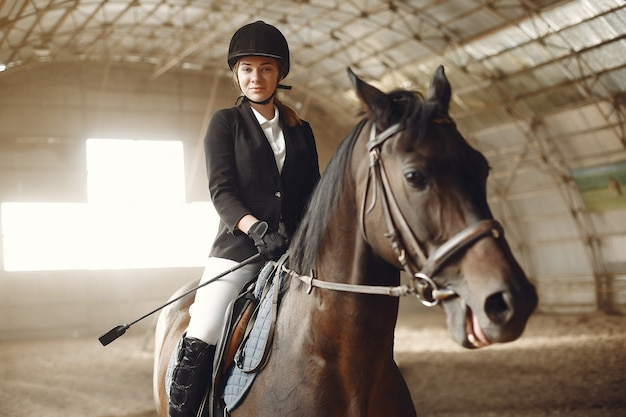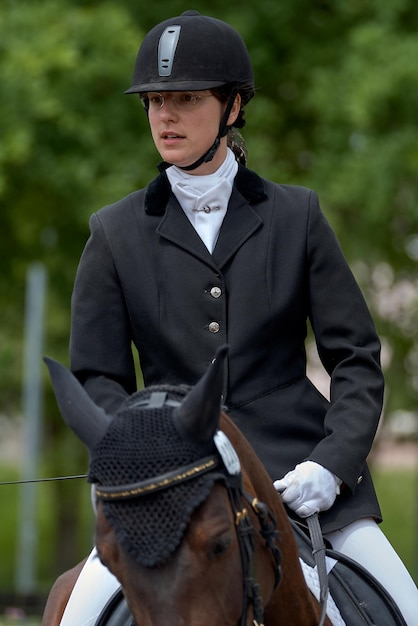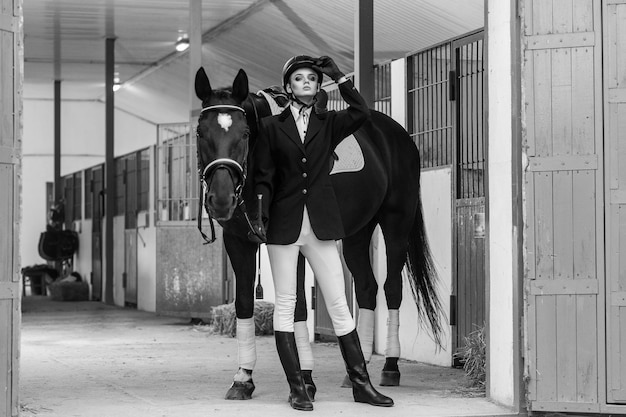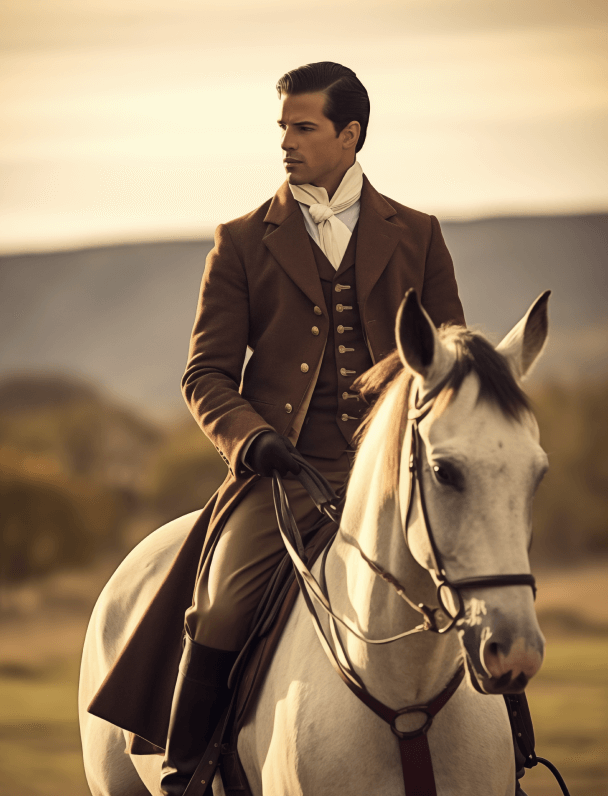
Are you searching for custom equestrian apparel? You may also want to learn more about equestrian apparel to assist you in making the correct choices for your riding wardrobe. Equestrian apparel is more than just clothes; it is a perfect combination of tradition, safety, and functionality, representing the richness of history and the dynamic nature of horseback riding. Whether you're a seasoned rider or a total beginner, knowing the basics about equestrian apparel will help you show your style in comfort and safety.
This guide gives comprehensive insights into choosing the right equestrian wear based on riding disciplines and levels of experience. From safety gear to stylish accessories, we have got you covered for every riding activity. Let's dive in!
First, let's discuss the essential equipment needed for professional and complete equestrian showing attire:
Wearing an ASTM/SEI certified helmet is a must in equestrian sports, providing essential protection. Traditional equestrian helmets come in various designs, allowing riders to choose styles that match their attire while ensuring safety.
· Show Shirts: Typically all white or light-colored, featuring white collars and cuffs. They are tailored to prevent snagging on equipment.
· Casual and Training Shirts: Includes polo shirts, T-shirts, short sleeves, and tank tops made from moisture-wicking fabrics to ensure comfort during training sessions.
· Show Jackets: Required for formal competitions, generally in dark colors and of a stretch material to accommodate free movements.
· Casual Jackets: Light in weight, warm, and suitable for everyday riding; melding traditional style with functionality of modern times.
· English Breeches: White, light gray, or beige color, usually with grip panels on the inner knees for better grip in the saddle while making jumps and sharp turns.
· Western Riding Pants: Jeans or special riding pants made of hard-wearing and comfortable material for flexibility and protection.
· English Riding Boots: Taller boots for formal competitions and ankle-length boots for casual riding. They have a heel from 1 to 1.5 inches and ankle support to prevent the foot from slipping through the stirrup.
· Western Riding Boots: Extremely stylish, yet highly practical, cowboy boots manufactured tough enough to provide years of trusty service in most traditional Western riding disciplines.
· Riding Gloves: Protect hands from abrasions and improve reins grip; usually made from leather or synthetic materials in neutral colors.
· Accessories: Belts, spurs, cufflinks, and minimalist jewelry add personal touches to equestrian attire without sacrificing performance.

Selecting the appropriate equestrian attire for various riding disciplines and occasions is crucial:
Includes beige-colored breeches, all white or light-colored shirts, dark show jackets, and shiny tall boots. Jumping competitions are dangerous and thus require certified and correctly worn helmets for the safety of riders. Additionally, investing in custom formal wear can enhance both style and functionality during competitions.
Aesthetically designed, usually consisting of white breeches, white shirts with bow ties, dark show jackets, stiff high-gloss boots, and gloves of neutral colors. Newer designs include fancy patterns along with unusual cuts to give an elegant look.
Traditional in conservative and simplified outlook, typically retains light-colored breeches and special vests that feature a Melton wool hunting jackets to meet hunter attire qualifications.
Is characterized by functionality, protection such as lightweight wicking apparel combined with tough boots and protection with helmets to allow comfort during long-distance rides.
Comfort and practicality are key, usually with flexible breeches or special jeans, custom Smart Casual, comfortable jackets, and hardy boots. Besides, accessories such as sunglasses and gloves can be added to adapt to different weather conditions.
The attire includes Western shirts, jeans, cowboy boots, and wide-brimmed hats, further accessorized with protective leg gear and spurs to complete the classic cowboy look.
Picking the right equestrian wear, depending on your riding skill level, can make all the difference in your performance and comfort:
Emphasizes safety, selecting certified helmets, comfortable breeches or riding pants, and tough boots with a 1 to 1.5-inch heel. Beginners should invest in moderately priced, well-fitting gear to ensure safety and comfort without excessive spending.
With experience, it is time to introduce technical fabrics and more specialist equipment. At this point, balancing practicality with breathable fabrics and more interesting cuts creates a better combination of performance and look.
Highly professional riders would require advanced materials to achieve maximum performance and durability.
Professional equestrian outfits will combine high-end fashion features with the strict standards of competitions to meet the highest demands of elite riding. To further customize your professional gear, consider made to measure suits online for the perfect fit.

Wear clothes that allow for freedom of movement. Breathable, elastic, and durable materials can do this for you. This keeps you comfortable and free in your ride.
Follow safety rules such as using certified helmets and appropriate boots. Take care of the equipment to ensure the working efficiency.
Blend modern trends into traditional styles. Wear style of riding discipline.
Keep horse and rider color, style coordinated for good-looking presentation and good team working.
Brands like Ariat, Pikeur, and Horze have the market advantage of quality and fashion in equestrian apparel across a number of riding disciplines for various experience levels.
Different disciplines may require specialized brands. For example, Breezer is excellent for dressage and eventing, Driza-Bone offers reliable outerwear for various riding conditions, Pikeur and Animo are perfect for dressage, and Justin Boots and Wrangler excel in Western riding.
These come with fabulous options for all budgets, starting from affordable ones like Dover Saddlery to very high-end brands like Pikeur.
Follow the manufacturer's directions related to washing and drying any garment. Store the outfits in a cool, dry area, away from direct sunlight to avoid deterioration.
Regularly inspect safety equipment for wear and tear and replace immediately when damaged.
The ways to make gear last longer include fixing minor damages quickly and avoiding extreme use conditions. Invest in good clothes and follow the care routines to keep them functional and good looking. Fix minor damages in time and avoid harsh condition use to make gear last.
With this ultimate equestrian fashion guide, we hope we could empower you in selecting your riding gear in a lot more confident way. It is very obvious that correct attire will enhance riding experiences of both the professionals and freshers, be it keeping you safe or elevating style.
For those looking to elevate their riding wardrobe with personalized touches, Kutetailor offers bespoke equestrian attire tailored to your unique style and needs. Our expert tailors work with you to create custom-fit garments that meet both your aesthetic preferences and functional requirements. Visit Kutetailor today to design your perfect riding gear and experience the difference of customized excellence.
Wishing you enjoyable and stylish rides on your equestrian journey!

Beginners should prioritize safety and comfort, including a certified helmet, comfortable breeches or riding pants, sturdy boots with a 1 to 1.5-inch heel, and breathable shirts.
Wear an ASTM/SEI certified helmet that fits tightly but is not too tight, covers all the right parts of the head, and is comfortable to wear. Replace the helmet immediately after a fall or accident.
Jumping competition attire: light-colored breeches, all white or light-colored shirts, dark show jackets, and shiny tall boots. Dressage is a bit more formal: white breeches, white shirts with bow ties, dark show jackets, rigid high-gloss boots, and gloves.
It's best to wear flexible, moisture-wicking riding pants or specially designed jeans to keep you comfortable and prevent chafing.
The must-haves are a certified helmet, gloves, belt, spurs, cufflinks, casual riding sunglasses, and reflective gear for visibility.